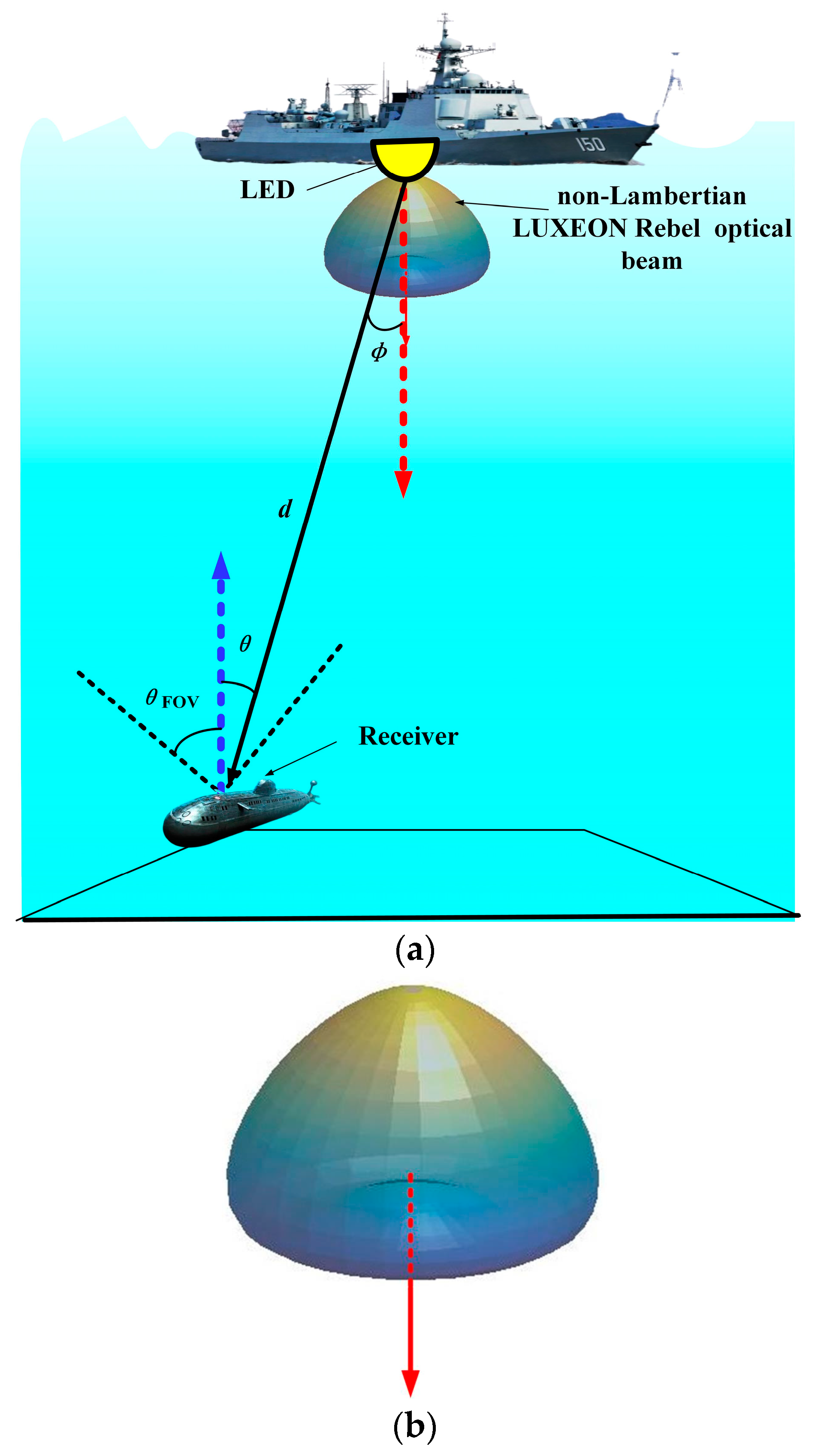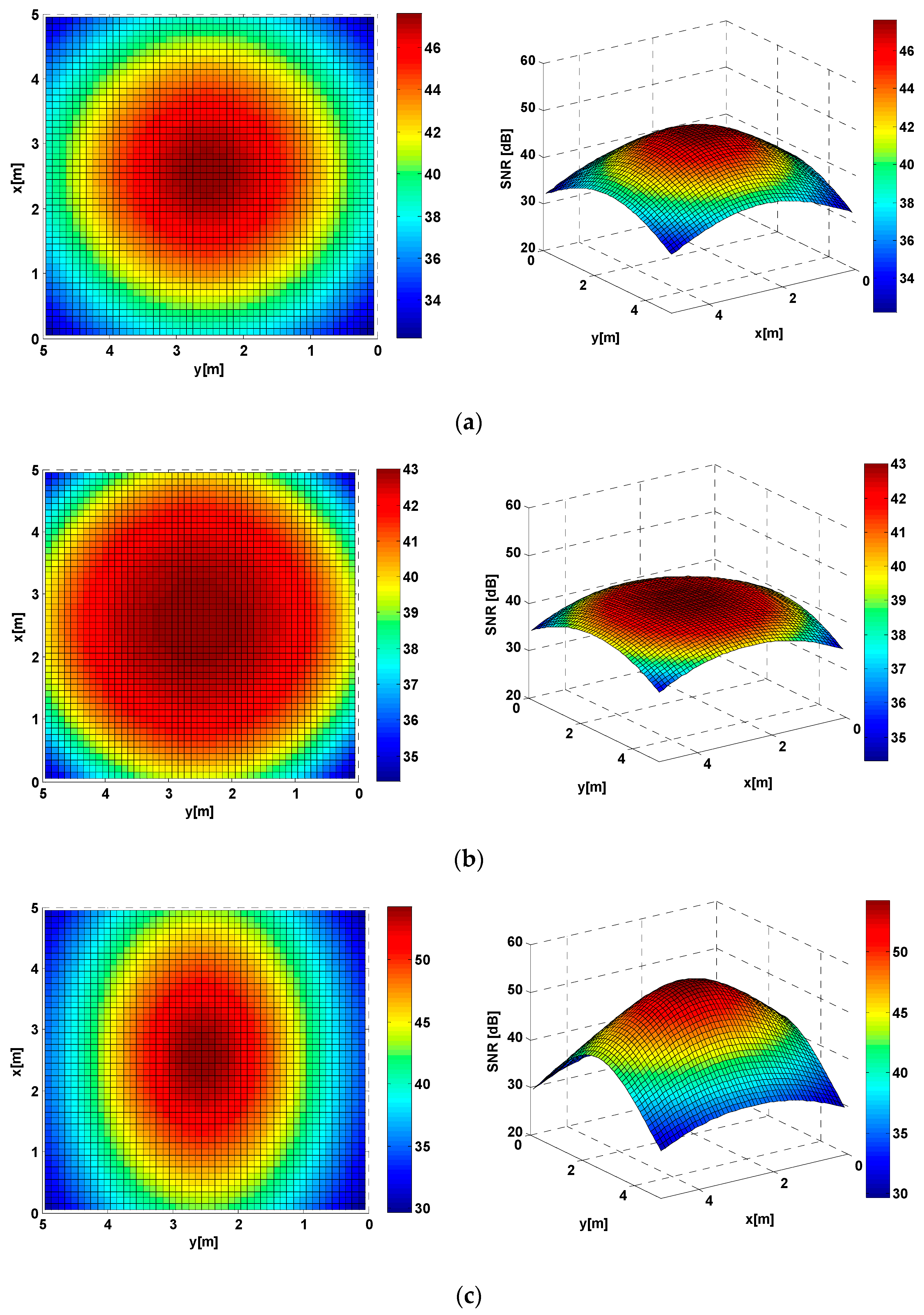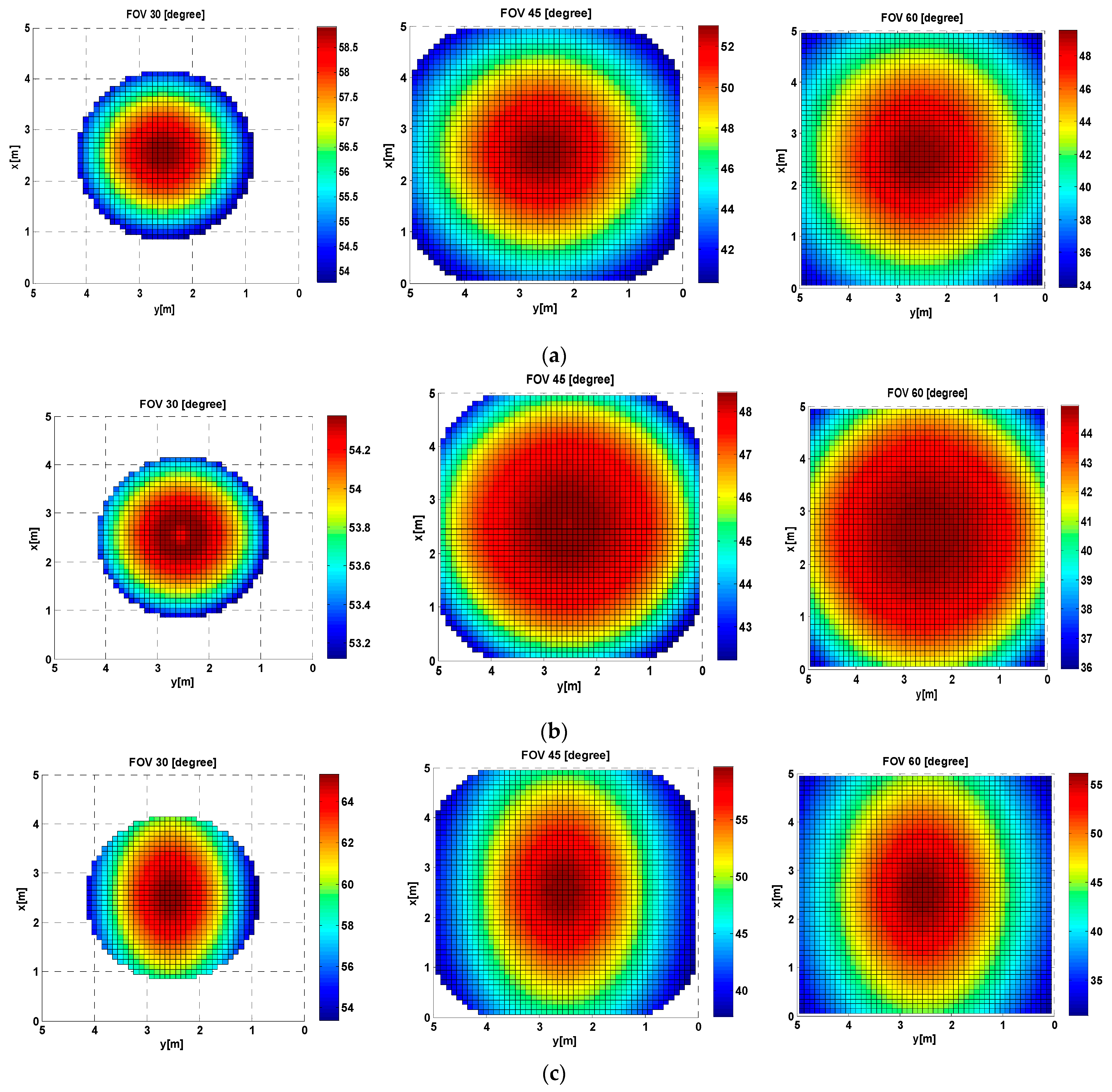Coverage Performance of Non-Lambertian Underwater Wireless Optical Communications for 6G Internet of Things
Abstract
:1. Introduction
2. Underwater Wireless Optical Communications Based on Distinct Optical Beam Configurations
2.1. Underwater Wireless Optical Communications Based on Baseline Lambertian Optical Beam Configuration
2.2. Underwater Wireless Optical Communications Based on Distinct Non-Lambertian Optical Beam Configuration
3. Numerical Evaluation
3.1. Effect of Different Water Type
3.2. Effect of Receiver FOV
3.3. Effect of Receiver Depth
3.4. Effect of Receiver Aperture Size
4. Conclusions
Author Contributions
Funding
Institutional Review Board Statement
Informed Consent Statement
Data Availability Statement
Conflicts of Interest
References
- Chowdhury, M.Z.; Hossan, M.T.; Islam, A.; Jang,, Y.M. A comparative survey of optical wireless technologies: Architectures and applications. IEEE Access 2018, 6, 9819–9840. [Google Scholar] [CrossRef]
- Hamza, A.S.; Deogun, J.S.; Alexander, D.R. Classification framework for free space optical communication links and systems. IEEE Commun. Surv. Tuts. 2019, 21, 1346–1382. [Google Scholar] [CrossRef]
- Zhang, J.; Gao, G.; Wang, B.; Guan, X.; Yin, L.; Chen, J.; Luo, B. Background Noise Resistant Underwater Wireless Optical Communication Using Faraday Atomic Line Laser and Filter. J. Light. Technol. 2022, 40, 63–73. [Google Scholar] [CrossRef]
- Zhou, H.; Zhang, M.; Wang, X.; Ren, X. Design and Implementation of More Than 50m Real-Time Underwater Wireless Optical Communication System. J. Light. Technol. 2022, 40, 3654–3668. [Google Scholar] [CrossRef]
- Ijeh, I.C.; Haddad, O.; Khalighi, M.A. Ergodic Capacity of a Vertical Underwater Wireless Optical Communication Link Subject to Misalignment. In Proceedings of the 2022 4th West Asian Symposium on Optical and Millimeter-Wave Wireless Communications (WASOWC), Tabriz, Iran, 12–13 May 2022; IEEE: New York, NY, USA, 2022. [Google Scholar]
- Pandey, P.; Matta, G.; Aggarwal, M. Investigation of photodetector responsivity on the performance of underwater optical wireless communication systems. In Proceedings of the OCEANS 2022, Chennai, India, 21–24 February 2022; IEEE: New York, NY, USA, 2022. [Google Scholar]
- Liu, A.; Yuan, Y.; Yin, H.; Zhao, H.; Fu, X. Optimization of LED Array Spatial Coverage Characteristics in Underwater Wireless Optical Communication. J. Mar. Sci. Eng. 2023, 11, 253. [Google Scholar] [CrossRef]
- Wang, X.; Luo, H.; Yang, Y.; Ruby, R.; Wu, K. Underwater Real-time Video Transmission via Optical Channels with Swarms of AUVs. In Proceedings of the 2021 IEEE 27th International Conference on Parallel and Distributed Systems (ICPADS), Beijing, China, 7–9 February 2022; IEEE: New York, NY, USA, 2022. [Google Scholar]
- Amalia, A.I.; Hambali, A.; Pamukti, B. Performance Analysis of on-off Keying Modulation on Underwater Visible Light Communication. In Proceedings of the 2020 6th International Conference on Science and Technology (ICST), Yogyakarta, Indonesia, 7–8 September 2020. [Google Scholar]
- Moreno, I.; Sun, C.-C. Modeling the radiation pattern of LEDs. Opt. Exp. 2008, 16, 1808–1819. [Google Scholar] [CrossRef] [PubMed]
- Nakagawa, M. Fundamental analysis for visible-light communication system using LED lights. IEEE Trans. Consum. Electron. 2004, 50, 100–107. [Google Scholar]
- Ding, J.; Chih-Lin, I.; Xu, Z. Indoor optical wireless channel characteristics with distinct source radiation patterns. IEEE Photonics J. 2016, 8, 7900115. [Google Scholar] [CrossRef]
- Ding, J.; Zhao, K.; Liu, S. Exploring the Effect of optical beams on hybrid VLC/RF transmission characteristics. Photonics 2023, 10, 185. [Google Scholar] [CrossRef]
- Yang, C.; Yang, F. Communication Interruption Analysis for Air-water Wireless Optical Communication. In Proceedings of the 2023 International Wireless Communications and Mobile Computing (IWCMC), Marrakesh, Morocco, 19–23 June 2023. [Google Scholar]









| Symbols | Explanations |
|---|---|
| emission angle of optical signal | |
| Lambertian index | |
| semi-angle at half-power of average transmitted optical source | |
| active area of optical detector | |
| incident angle of captured optical signal | |
| field of view of receiver | |
| transmission gain of optical filter gain of non-imaging optical concentrator | |
| d | distance between optical source and receiver |
| the emitted optical power | |
| optical loss factor of line of sight communication link | |
| beam extinction coefficient | |
| absorption coefficient of water medium involved | |
| scattering coefficient of water medium involved |
| Parameters | Values |
|---|---|
| Baseline underwater space size (W × L × H) | 5 × 5 × 3 m3 |
| Emitted power of transmitter | 10 W |
| Number of transmitter | 1 |
| Location of transmitter | (2.5, 2.5, 0) m |
| LED Lambertian index | 1 |
| Receiver field of view | 90° |
| Depth of receiving plane | 3.0 m |
| Type of photodiode | PIN PD |
| Physical area of PD | 1.0 cm2 |
| Responsively of PD | 0.28 A/W |
| Concentrator refractive index | 1.54 |
| Optical filter gain | 1 |
| LED Modulation bandwidth | 20 MHz |
| Absorption coefficient of pure seawater | 0.053 m−1 |
| Scattering coefficient of pure seawater | 0.003 m−1 |
| Absorption coefficient of clear seawater | 0.069 m−1 |
| Scattering coefficient of clear seawater | 0.08 m−1 |
| Absorption coefficient of coastal seawater | 0.088 m−1 |
| Scattering coefficient of coastal seawater | 0.216 m−1 |
| Absorption coefficient of turbid seawater | 0.295 m−1 |
| Scattering coefficient of turbid seawater | 1.875 m−1 |
| Electron charge q | 1.69 × 10−19 C |
| 1.38 × 10−23 K | |
| Temperature T | 300 K |
| 50 Ω |
Disclaimer/Publisher’s Note: The statements, opinions and data contained in all publications are solely those of the individual author(s) and contributor(s) and not of MDPI and/or the editor(s). MDPI and/or the editor(s) disclaim responsibility for any injury to people or property resulting from any ideas, methods, instructions or products referred to in the content. |
© 2024 by the authors. Licensee MDPI, Basel, Switzerland. This article is an open access article distributed under the terms and conditions of the Creative Commons Attribution (CC BY) license (https://creativecommons.org/licenses/by/4.0/).
Share and Cite
Ding, J.; I, C.-L.; Wang, J.; Song, J. Coverage Performance of Non-Lambertian Underwater Wireless Optical Communications for 6G Internet of Things. Inventions 2024, 9, 49. https://doi.org/10.3390/inventions9030049
Ding J, I C-L, Wang J, Song J. Coverage Performance of Non-Lambertian Underwater Wireless Optical Communications for 6G Internet of Things. Inventions. 2024; 9(3):49. https://doi.org/10.3390/inventions9030049
Chicago/Turabian StyleDing, Jupeng, Chih-Lin I, Jintao Wang, and Jian Song. 2024. "Coverage Performance of Non-Lambertian Underwater Wireless Optical Communications for 6G Internet of Things" Inventions 9, no. 3: 49. https://doi.org/10.3390/inventions9030049
APA StyleDing, J., I, C.-L., Wang, J., & Song, J. (2024). Coverage Performance of Non-Lambertian Underwater Wireless Optical Communications for 6G Internet of Things. Inventions, 9(3), 49. https://doi.org/10.3390/inventions9030049






